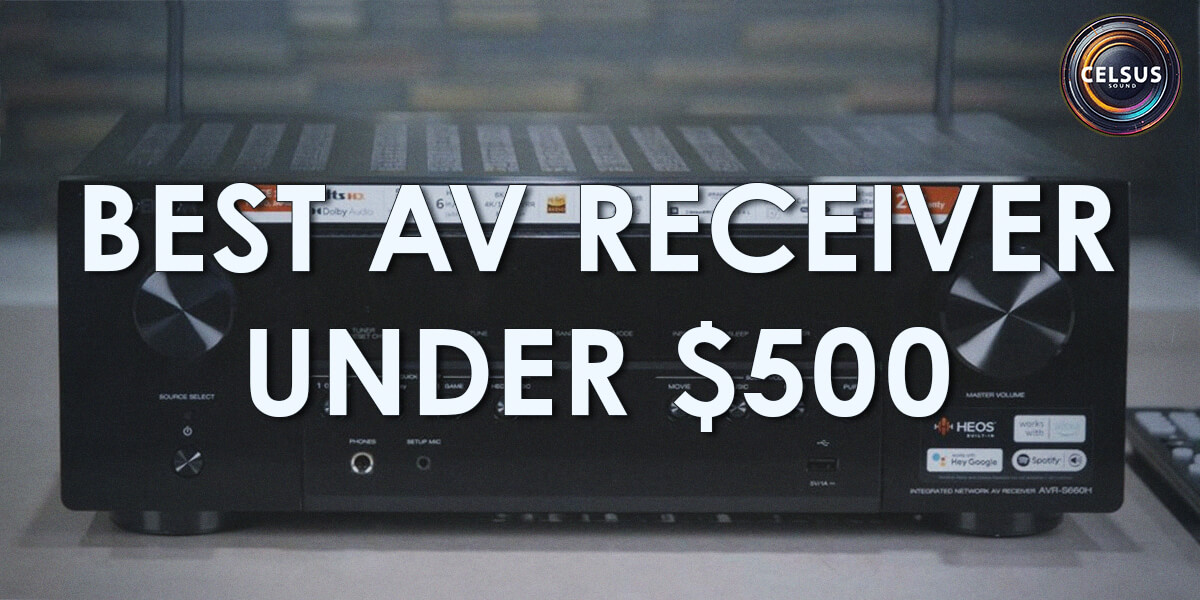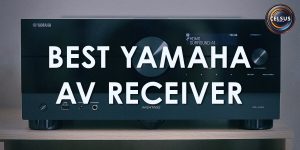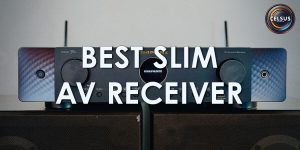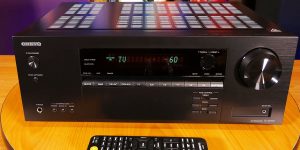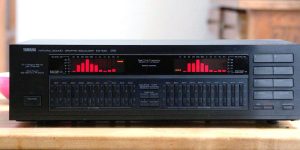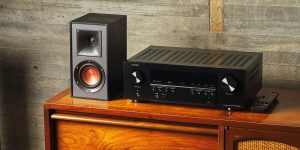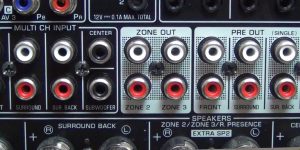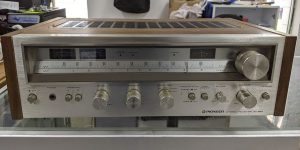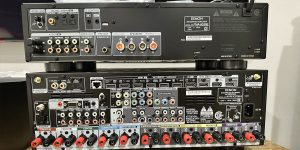Do you want to optimize your multimedia system and buy a good receiver? Is your budget limited, or do you just not want to overpay for unnecessary functionality? If so, I have prepared a list of the best receivers under $500 for you. I can assure you that it’s possible to get worthy results even from a mid-range AVR at a reasonable price.
Don’t be surprised when you see devices from different manufacturers here. I did it on purpose so that you can compare the benefits of various brands and select the most suitable model for yourself. Let’s not waste time and move on to the reviews of the models I have selected.
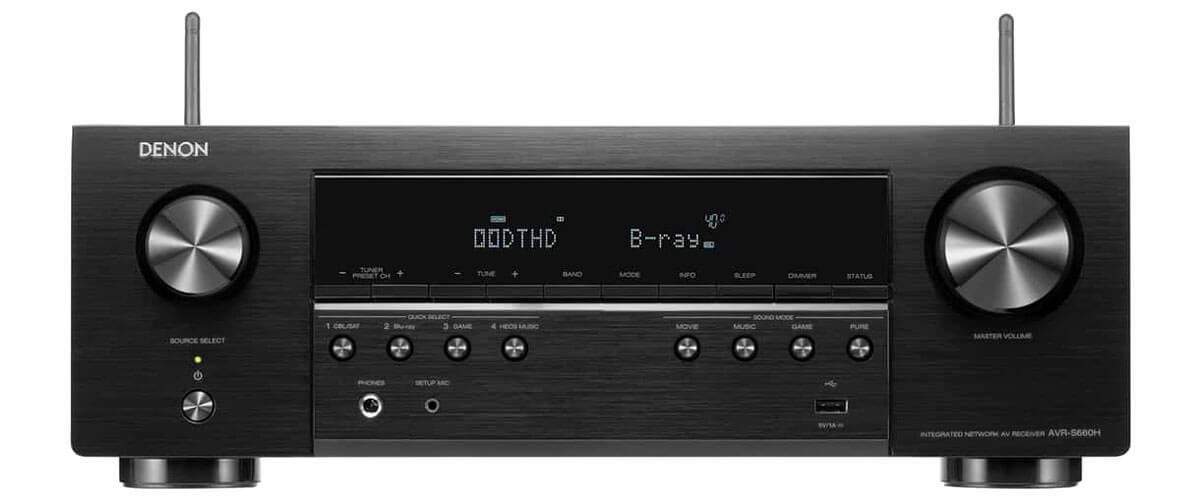
AV receivers under $500 comparison table
| Name | Channels | Power output | HDMI in/out | Bluetooth/Wi-Fi | Review |
|---|---|---|---|---|---|
| Denon AVR-S670H best overall | 5.2 | 75W/8 Ohm, 100W/6 Ohm | 6/1 | yes/yes | Review |
| Sony STR-DH790 | 7.2 | 90W/6 Ohm | 4/1 | yes/no | Review |
| Yamaha RX-V4A | 5.2 | 80W/6 Ohm | 4/1 | yes/yes | Review |
| Pioneer Elite VSX-LX104 | 5.2 | 80W/8 Ohm, 170W/6 Ohm | 6/2 | yes/yes | Review |
| Onkyo TX-SR494 | 7.2 | 80W/6 Ohm, 160W/6 Ohm | 4/1 | yes/no | Review |
Best AV receiver under $500 reviews
Denon AVR-S670H – best overall

I want to start with my favorite, the Denon AVR-S670H. This is the most modern model on my list, which was released in 2023 and replaced the Denon AVR-S660H. After testing many analogs in this price range, I can confidently say that the S660H is the best AVR under $500. And now, let’s take a closer look at it, and you will understand why I called it the leader in this nomination.
The device has a 5.2 channel amplifier with about 75 watts per channel (8 ohms, 20 Hz – 20 kHz, THD: 0.08%). It’s not outstanding power, but it’s more than enough for excellent performance in small to medium-sized rooms.
The AVR-S670H can deliver a high-quality and atmospheric picture with excellent detail. This is understandable since, in addition to basic video capabilities, the model supports 8K resolution at 60Hz. It also features Dolby Vision and HDR10+. In addition, this receiver is also game-oriented and supports special technologies such as Auto Low Latency Mode, Variable Refresh Rate, and Quick Frame Transport. So I’ll give this model the first big plus for the excellent picture quality and availability of gamer features.
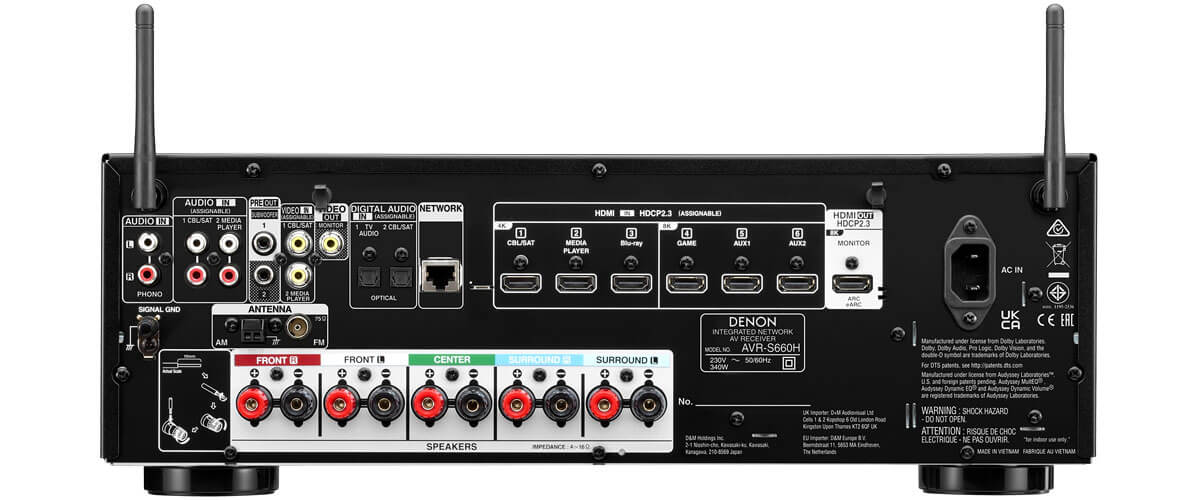
The device understands and processes different audio formats very well (Lossy and Lossless). As for sound calibration, everything is easy. Thanks to Audyssey MultEQ technology, you can quickly adjust the sound according to your room’s parameters. By the way, the AVR-S660H supports voice control via Alexa, Apple Siri, and Google Assistant. Quick setup and easy receiver control are the second significant advantage of the Denon AVR-S670H.
This rather compact AV receiver has six HDMI inputs (2.1); three of them support 8K resolution with HDCP 2.3 and ARC/eARC technology. Unfortunately, there is one HDMI output, but I can’t call this a disadvantage of the AVR as this is a common situation for models of this range. Available connection methods include two subwoofer outs, Bluetooth, Wi-Fi, and Ethernet Ports. Phono (MM) input is an additional advantage.
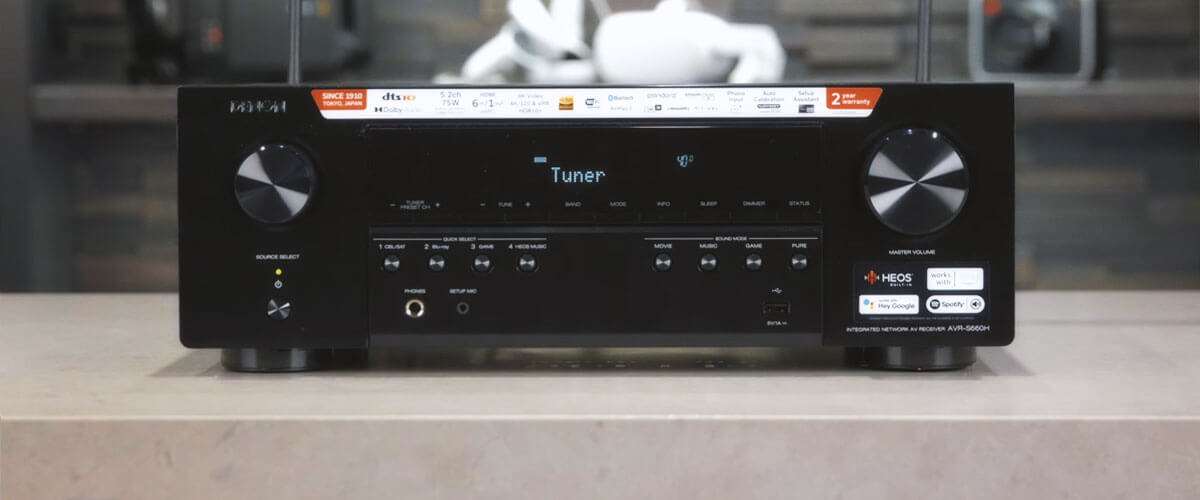
The device supports DTS HD Master, Dolby TrueHD, and multichannel stereo. After conducting various tests, I can confidently say that the sound is at a decent level. It sounds clean and dynamic, and I did not notice any significant distortion, even at high volume. However, running at high volume for long periods will cause the device to heat up quite a bit. This does not affect its operation in any way, but you should keep it in mind.
The Denon AVR-S670H looks a little better when compared with the Yamaha RX-V4A. Both receivers offer similar video and sound quality. But in my opinion, Denon sounds more detailed. In addition, it has six HDMI inputs instead of Yamaha’s four and a Phono input.
According to the results of my numerous tests I can confidently call the AVR-S660H – the best AV receiver under $500 in my top. It has the necessary sound quality, did not let me down during video tests, and is game-oriented, versatile, and easy to use. All this distinguishes it from its competitors.
Key specs
- Channels: 5.2.
- Power output: 75W/8 Ohm, 100W/6 Ohm.
- HDMI inputs/outputs: 6/1.
- Video functions: 4K/60Hz, 4K/120Hz, 8K/60Hz pass-through, upscales HD video signals to 8K Ultra HD.
- Bluetooth/Wi-Fi: yes/yes.
- Streaming services: AirPlay 2, Pandora, Spotify, Napster, SiriusXM, TIDAL, Deezer, Qobuz, Amazon Music.
- Suppots: HDMI ARC, HDMI eARC, HDMI CEC, HDCP2.3, HDR10+, Dolby Vision.
- Surround sound: DTS HD Master, Dolby TrueHD, Dolby ProLogic II.
Pros
- Advanced 8K pass-through.
- HDR10+ support.
- Game-oriented.
- Voice control is available.
- All HDMI ports are version 2.1.
- The Phono input is present.
Cons
- The receiver can sometimes overheat.
Sony STR-DH790
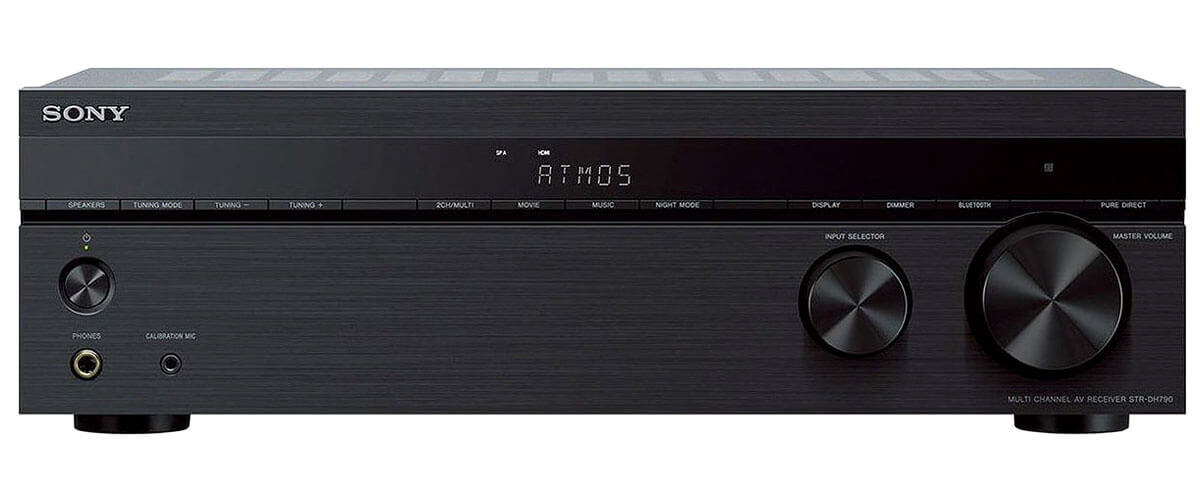
The second model which I want to offer you is the STR-DH790. Sony released it in 2018 after the STR-DH590. Although time has passed since then, it is still relevant.
The receiver has a 7.2 channel amplifier with 145 watts of power (6 ohms, 1kHz, 1ch THD 0.9%). If you use this device with a broader frequency range and 8-ohm speakers, its power will be less. I also want to draw your attention to the fact that the model does not work with 4-ohm speakers.
As for the quality of the picture, it is at a high enough level. For regular movie watching, it will be quite enough. Sony STR-DH790 supports 4K, High Dynamic Range, and 3D formats via HDMI. Overall, I didn’t see anything special other models in the same price range don’t have.
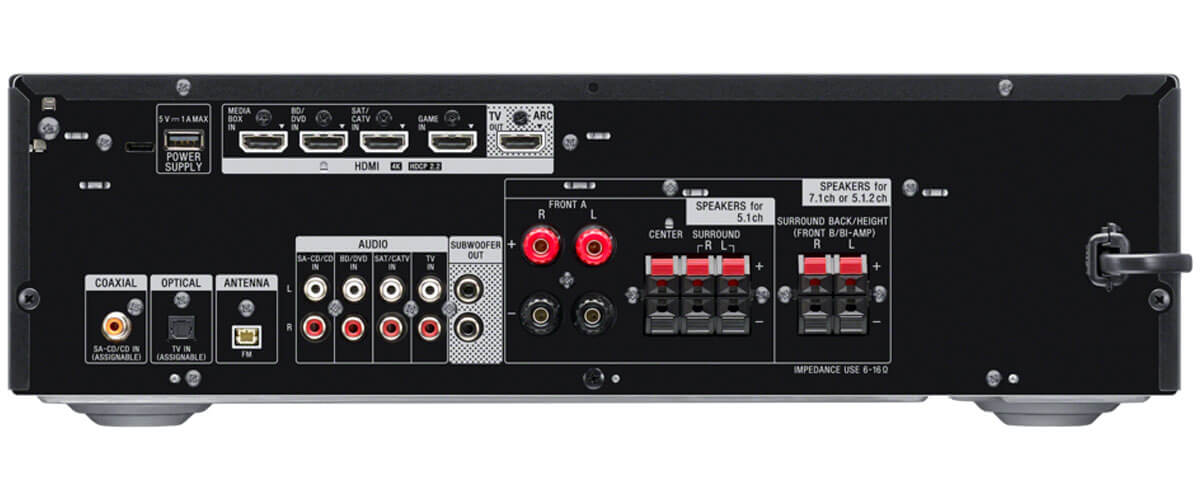
The receiver has four HDMI inputs (2.1) and one HDMI output (2.1) with HDCP 2.2/eARC support. Among the available connection methods, there are 2 subwoofer outs and Bluetooth. The lack of Wi-Fi is a rather serious disadvantage for me. I think that all modern models (starting from 2018) should have it.
Now, let’s talk a little bit about the sound itself. The device supports Dolby Atmos and DTS:X. It is worth noting that not all models in this price range can boast of surround sound technologies. Movies are played clearly, dynamically, and atmospherically. Also, the receiver supports Dolby Digital, Dolby Dual Mono, DTS-HD Master Audio, and DTS HD High-Resolution Audio.
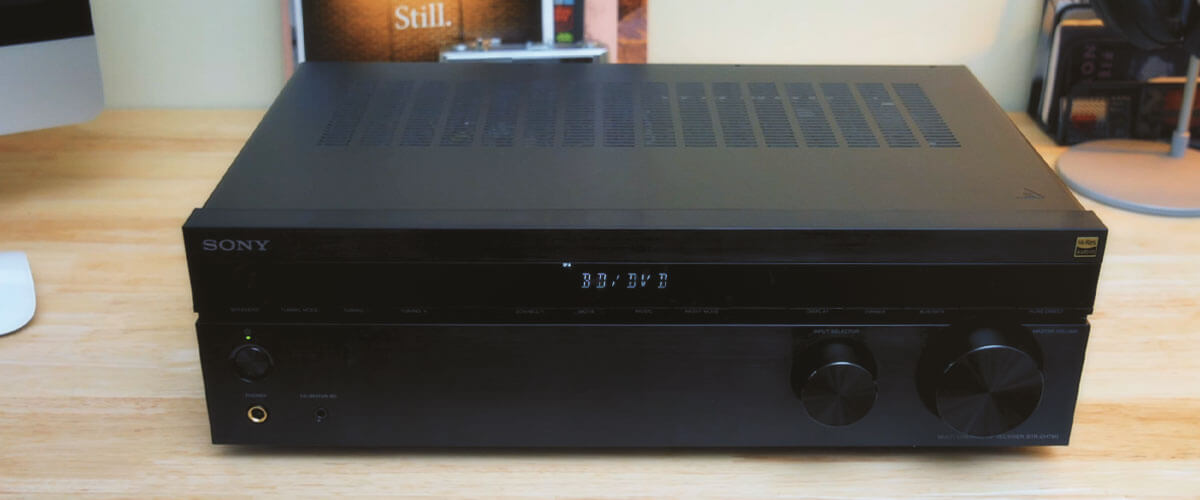
The Sony STR-DH790 and the Denon AVR-S660H are two good devices with slightly different benefits. The first model has a powerful amplifier, better music reproduction, and supports surround sound. In the second case, we have a more versatile receiver with 8К resolution and Phono input. Decide what’s more important for you.
The STR-DH790 is a home theater receiver under $500 that supports modern Dolby Atmos and DTS:X surround sound technologies and has the full range of basic features you need. Of course, there are certain shortcomings, but the model deserves to be on my list.
Key specs
- Channels: 7.2.
- Power output: 90W/6 Ohm.
- HDMI inputs/outputs: 4/1.
- Video functions: 4K/60Hz pass-through.
- Bluetooth/Wi-Fi: yes/no.
- Streaming services: no.
- Suppots: HDMI ARC, HDMI eARC, HDMI CEC, HDCP2.2, HLG, HDR10, Dolby Vision.
- Surround sound: DTS HD Master, DTS:X, DSD, Dolby Dual Mono, Dolby Atmos, Dolby Digital Plus, Dolby TrueHD.
Pros
- Dolby Atmos and DTS:X are present.
- There is a 4K pass-through.
- HDMI ports version 2.1.
Cons
- No Wi-Fi.
- Not compatible with 4-ohm speakers.
Yamaha RX-V4A
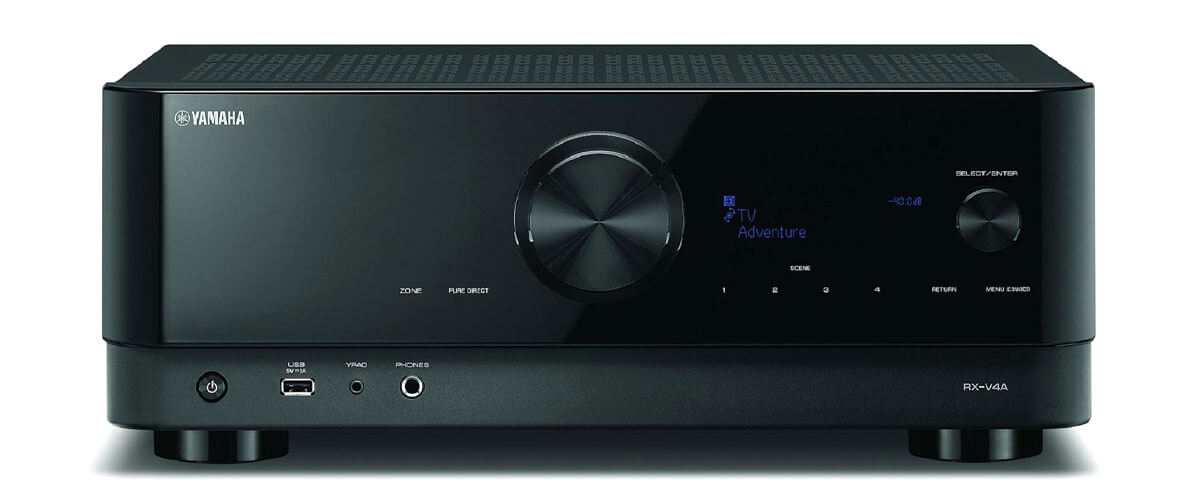
The next model I will tell you about is the Yamaha RX-V4A. It appeared on the market in 2020 and is the predecessor of the RX-V6A. Since this brand does not need much introduction, let’s move directly to the review of the device.
The receiver has a 5.2-channel amplifier with about 80 watts per channel (6 ohms, 0.06% THD). By the way, this model is even slightly more powerful than the best 5.1 receiver under 500 on my list (not by much, but still more powerful). The RX-V4A uses a high output slew rate amplifier that facilitates precise signal reproduction. As you can imagine, this is very important for a high-definition signal. Instability in the signal transfer is a characteristic of such amplifiers, but Yamaha’s unique circuit design does provide a stable transfer.
Yamaha RX-V4A supports 8K resolution at 60Hz. The picture looks very clear, contrasty, and with maximum detail. There is also support for various HDR formats, including Dolby Vision, HDR10+, and Hybrid Log-Gamma. Also, this model is focused on video games and supports all necessary formats to optimize video in the gameplay.
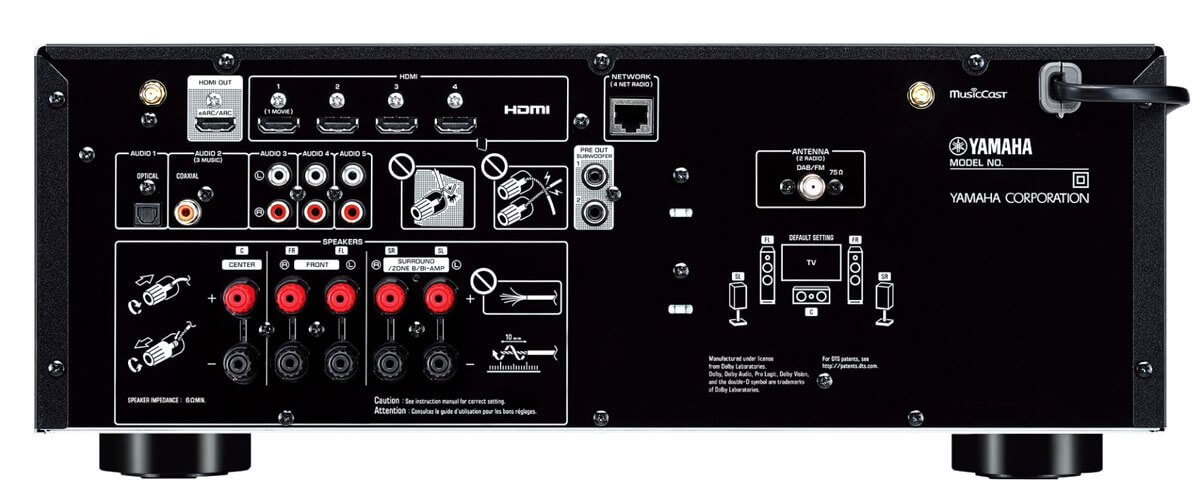
In terms of connectors and available connection methods, the model has 4 HDMI inputs (2.1/eARC) and 1 HDMI output (2.1) with HDCP 2.3. If we look at the possible connections, in our case, there are 2 subwoofer outs, Wi-Fi and Bluetooth. I think a lot of people will be happy to see AirPlay 2 here.
An interesting feature of this model is the 4 SCENE buttons with song and station assignments. You can assign different input signals to them, as well as sound field programs, Music Enhancer (direct connection of compatible cell phones to the receiver), HDMI output, etc. In addition, you can select different sources as inputs. With these buttons configured, simply press the one you want and listen to your favorite music. The buttons can be reconfigured at any time.
This model supports not the most advanced surround sound technologies such as Dolby TrueHD, Dolby Digital Plus, and DTS-HD Master Audio. With Yamaha’s YPAO automatic sound calibration, you have the ability to adjust the sound to your room parameters easily and quickly. I cannot but mention CINEMA DSP 3D technology for movies, music, and games. It accurately reproduces the height effect, forming a true stereoscopic sound field in the room.
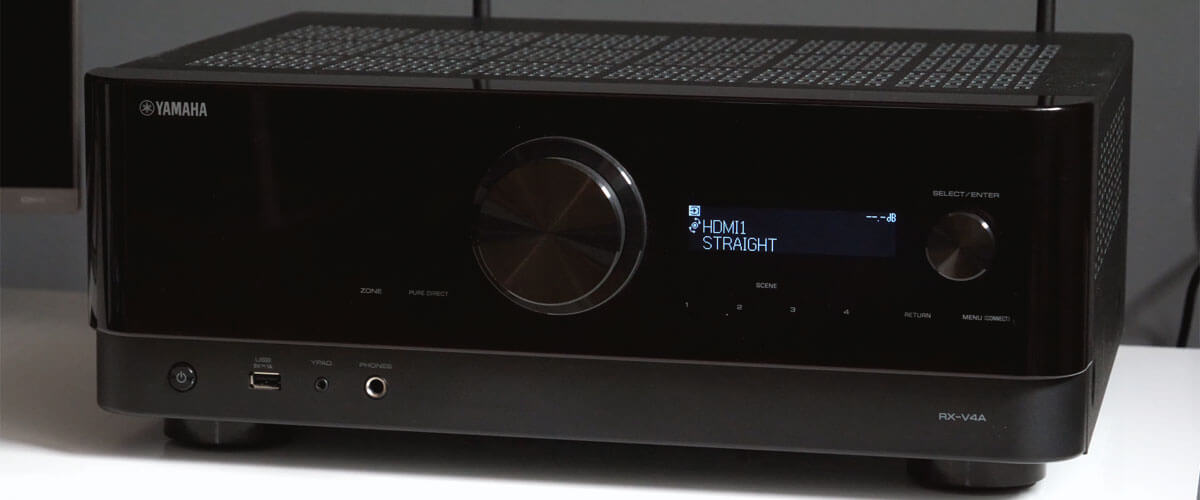
The RX-V4A also has a Multiroom audio system – MusicCast, streaming services support, voice control, and AV Setup Guide application for quick setup. Agree that the list is quite impressive.
All models from a brand like Yamaha are known for their quality, and the RX-V4A was no exception. Even though its competitor Sony STR-DH790 supports newer surround sound formats, the Yamaha RX-V4A does not sound much worse. But what really matters is that the model has 8K pass-through, support for enhanced media, and gaming. All these things make it a great receiver under $500.
The Yamaha RX-V4A is primarily suitable for viewing videos with 8K resolution and the latest HDR formats. Even though the AVR does not have the technology to enjoy surround sound fully, it will please you. An additional advantage of this model is the built-in data streaming system and the availability of the MusicCast multi-room audio system.
Key specs
- Channels: 5.2.
- Power output: 80W/6 Ohm.
- HDMI inputs/outputs: 4/1.
- Video functions: 4K/60Hz, 4K/120Hz, 8K/60Hz pass-through, upscales HD video signals to 4K Ultra HD.
- Bluetooth/Wi-Fi: yes/yes.
- Streaming services: AirPlay 2, Pandora, Spotify, Napster, SiriusXM, TIDAL, Deezer, Qobuz, Amazon Music, MusicCast.
- Suppots: HDMI ARC, HDMI eARC, HDMI CEC, HDCP2.3, HDR10, HDR10+, Dolby Vision.
- Surround sound: DTS HD Master, Dolby TrueHD, Dolby Digital Plus, Cinema DSP.
Pros
- 8K pass-through.
- It is possible to control by voice.
- CINEMA DSP 3D Technology.
- Quick and easy sound calibration with YPAO.
- Easy to use.
Cons
- No Dolby Atmos and DTS:X.
Pioneer Elite VSX-LX104
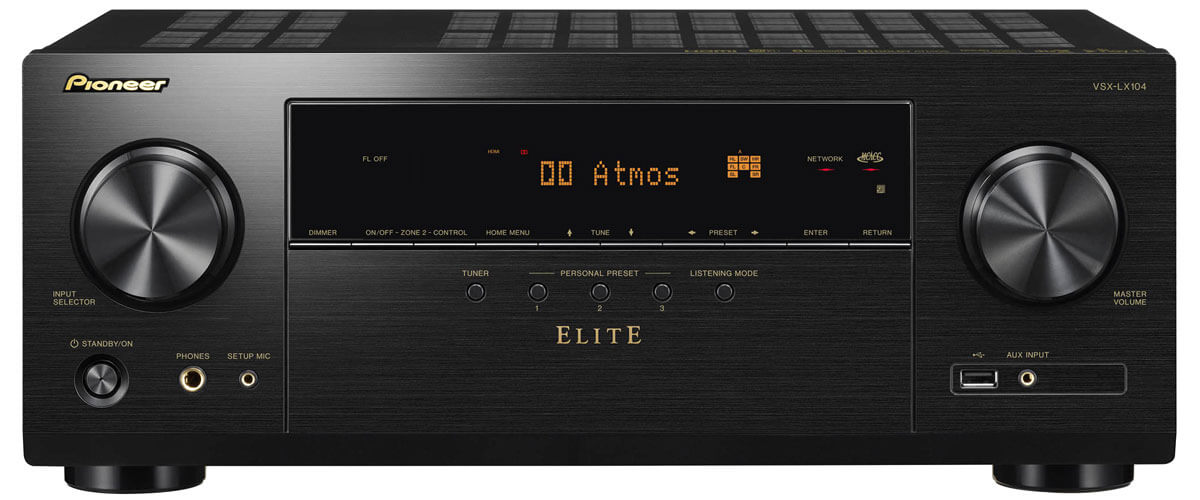
The penultimate model on my list is the Elite VSX-LX104. It was designed in 2019 by the Japanese Pioneer Corporation, which has been considered one of the leaders in various audio and video equipment for many years.. Its predecessor is the VSX-LX103.
The receiver is provided with a 7.2 channel amplifier with 80 watts per channel (8 ohms, 20Hz – 20kHz, 2 channel driven, THD: 0.08%). And I was pleased that this model can work with 4ohm speakers.
The VSX-LX104 offers its users picture quality in 4K Ultra HD resolution. But I also want to mention the presence of the IMAX Enhanced feature. It’s a kind of mini-copy of an IMAX theater and a definite plus for this model. Supported technologies include Dolby Vision, HDR10, HLG, and BT.2020. It is possible to view 3D content. As you can see, video functions are at a good level here.
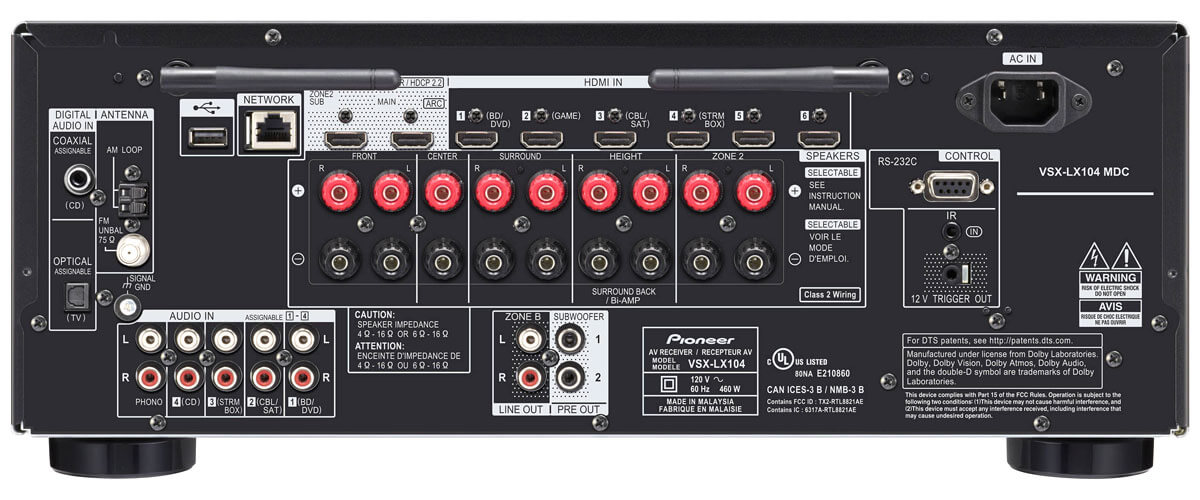
As for connections, the receiver has 6 HDMI inputs (version 2.0) on the rear panel and 2 HDMI outputs with HDCP 2.2 and ARC support. You can connect to the model via 2 subwoofer outputs, USB, Bluetooth, Ethernet ports, Wi-Fi (5 GHz/2.4 GHz) and Phono input.
The model supports surround sound with technologies such as Dolby Atmos и DTS:X, as well as a number of other formats. In cooperation with IMAX Enhanced, the sound is really good, and watching movies at home will definitely take you to the next level. So don’t forget to stock up on coke and popcorn.
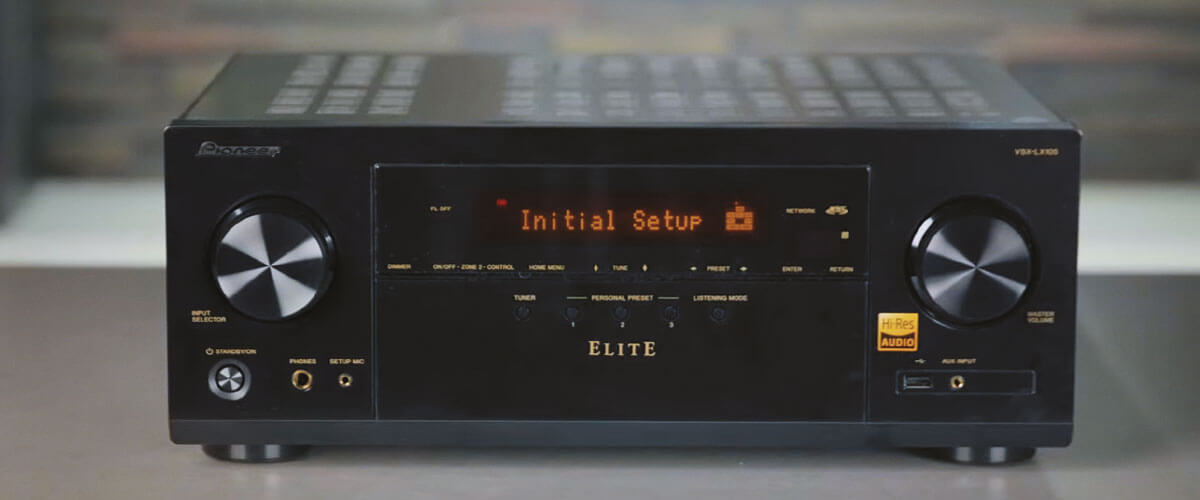
As for additional features of this model, it has the MCACC sound calibration system, Flare Connect wireless streaming technology, and it can stream video and music from Apple products to TVs/speakers via AirPlay 2.
The Pioneer Elite VSX-LX104 is a good surround sound receiver for under $500. In addition to high-quality surround music, it is ready to offer you a bright picture with IMAX Enhanced in 4K resolution, wireless streaming technology, and even can please lovers of vinyl records. But, you will have to put up with an older version of HDMI ports and the lack of eARC support.
Key specs
- Channels: 5.2.
- Power output: 80W/8 Ohm, 170W/6 Ohm.
- HDMI inputs/outputs: 6/2.
- Video functions: 4K/60Hz pass-through, upscales HD video signals to 4K Ultra HD.
- Bluetooth/Wi-Fi: yes/yes.
- Streaming services: AirPlay 2, Pandora, Spotify, Napster, SiriusXM, TIDAL, Deezer, Qobuz, Amazon Music, MusicCast.
- Suppots: HDMI ARC, HDMI CEC, HDCP2.3, HDR10, HGL, Dolby Vision.
- Surround sound: Dolby Atmos, DTS HD Master, Dolby TrueHD, Dolby Digital Plus, Dolby Atmos Height Virtualization, DTS:X, IMAX Enhanced.
Pros
- There is a 4K Ultra HD.
- Dolby Atmos and DTS:X.
- IMAX Enhanced is available.
- Phono (MM) In.
- Flare Connect for multi-room audio is present.
- MCACC room correction system.
- Supports 4-ohm speakers.
Cons
- The receiver supports the standard version HDMI (2.0b).
- No eARC support.
Onkyo TX-SR494
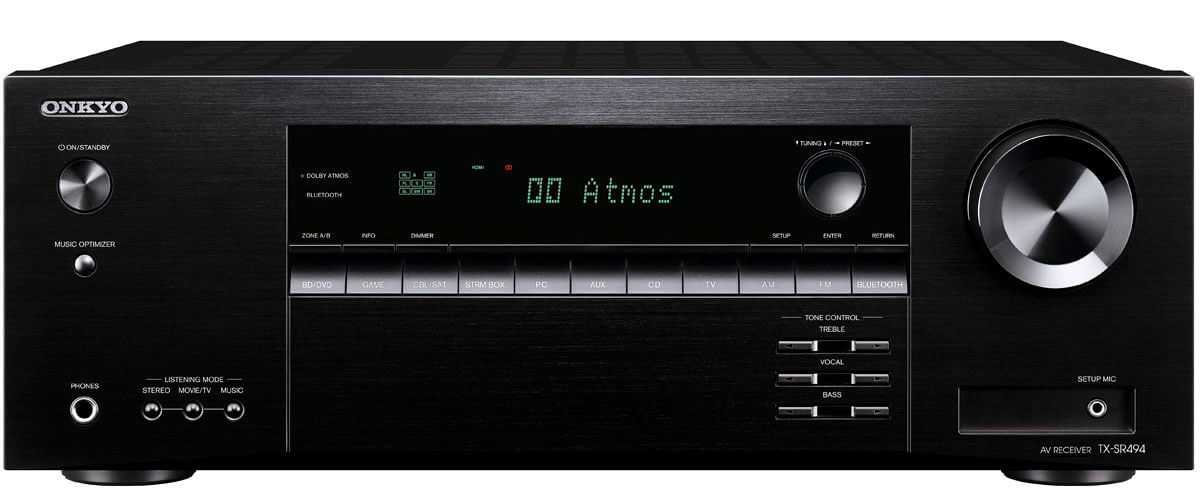
Finally, we came to the last model I included on this list, the Onkyo TX-SR494. It replaced the TX-SR393 in 2019 and offered its users more functionality than its predecessor. The new receiver has a 7.2 configuration and a number of proprietary technologies, particularly the function – Advanced Music Optimizer, which brings the quality of compressed formats closer to lossless quality. Dolby Atmos Height Virtualization is also available, which provides three-dimensional surround sound without overhead speakers.
This 4k receiver works with nine amplification channels, seven of which are made on discrete elements and deliver 160 watts of power per channel. This is a bit more than the younger 393 model. There is also an opportunity to sound a second room or make a bi-amping connection of the front speakers, and the receiver will work in a 5.2 configuration.
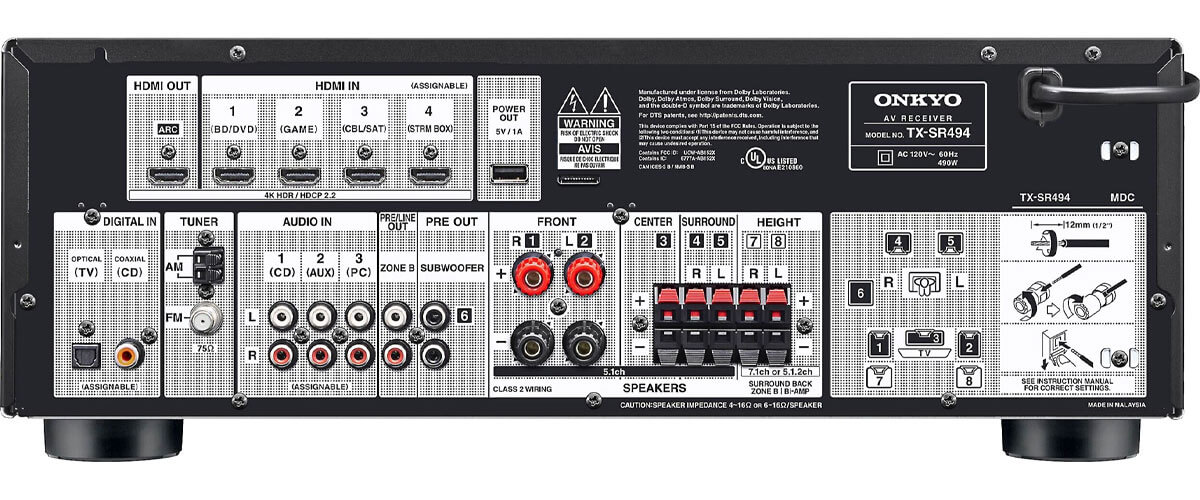
The audio circuit works on the AKM chip with up to 32 bits/384kHz resolution; two technologies are used for auto-calibration – AccuEQ and Accu Reflex. The latter is designed to optimize object-oriented Dolby Atmos sound. It also removes the phase shift that can occur due to the difference between direct and reflected sound waves, improves 3-D sound localization in the vertical plane, and gives a greater sense of overhead space.
The receiver has 4 HDMI inputs (2.0) and 1 HDMI output (2.0) with HDCP 2.3 / ARC support. If you need to connect to the TX-SR494, you can do so with two subwoofer outputs, USB input, and Bluetooth. Unfortunately, there are no connection methods, such as Wi-Fi and Ethernet ports. Also, Phono input is not available. I have to say that HDMI 2.0 and ARC are pretty old formats, so this is definitely a disadvantage of the model.
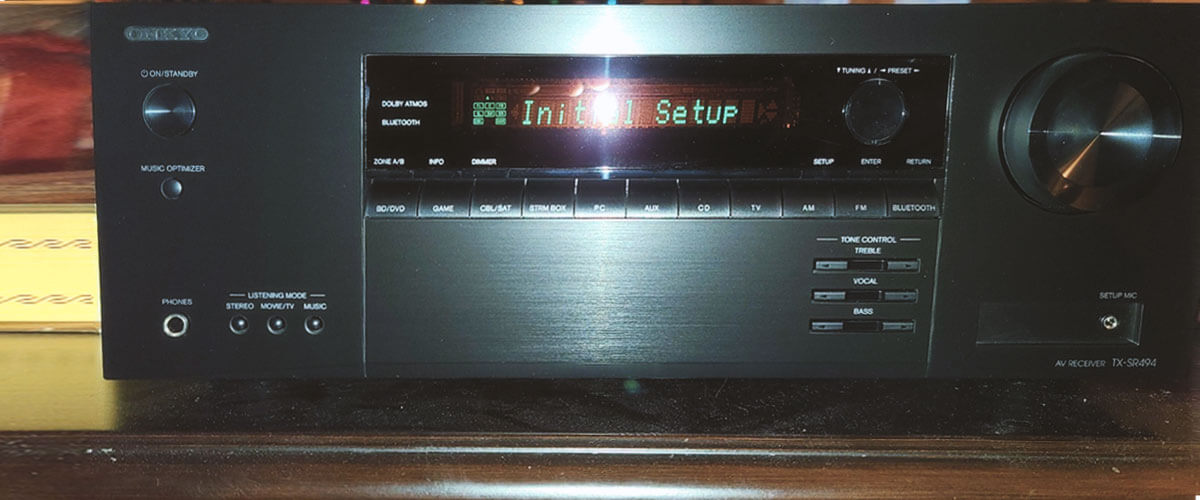
The video section is extensive – HDCP 2.2, 4K/60p, HDR (Dolby Vision, HDR10, HLG, BT.2020), color coding 4:4:4, and 3D Video.
The Onkyo TX-SR494 is great for home use. It can offer a clear 4K picture and a rather qualitative surround sound. There are certainly some drawbacks, but this model is definitely not an outsider in this price segment.
Key specs
- Channels: 7.2.
- Power output: 80W/8 Ohm, 160W/6 Ohm.
- HDMI inputs/outputs: 4/1.
- Video functions: 4K/60Hz pass-through.
- Bluetooth/Wi-Fi: yes/no.
- Streaming services: no.
- Suppots: HDMI ARC, HDMI CEC, HDCP2.3, HDR10.
- Surround sound: DTS HD Master, DTS:X, DTS Neural:X, DTS Virtual:X, Dolby TrueHD, Dolby Atmos, Dolby Digital Plus, Dolby Atmos Height Virtualization, Dolby Surround.
Pros
- 4K HDR pass-through.
- Auto speaker calibration AccuEQ.
- HDMI cable supports 3D and CEC.
- Dolby Atmos and DTS:X are present.
Cons
- The receiver does not support high-resolution audio formats.
- Flare Connect and Airplay are not available.
- Wi-Fi is not present.
- All HDMI ports are version 2.0.
What to expect from an AV receiver under $500?
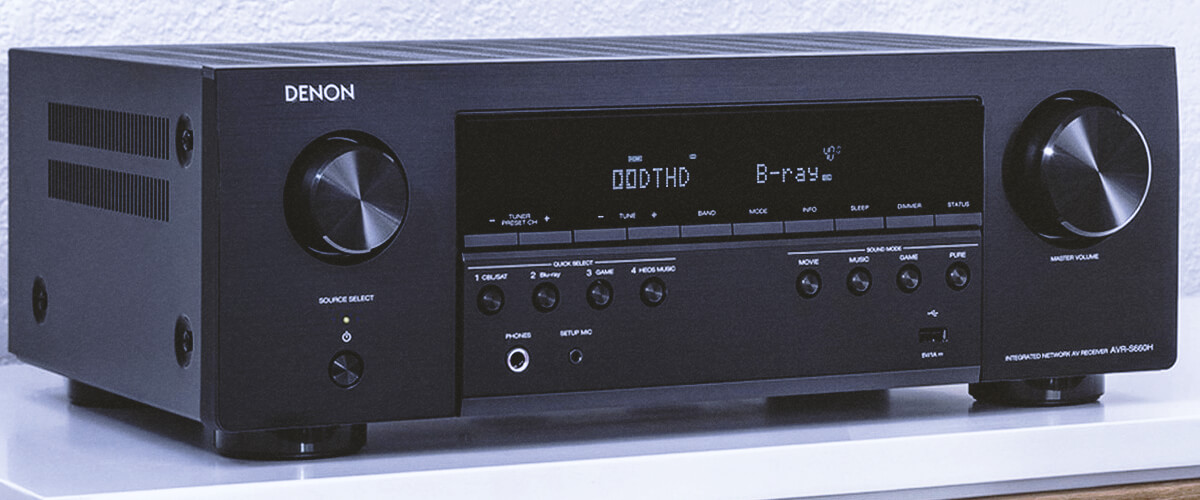
Well, let’s talk about what you should expect from receivers that cost under $500. Unlike budget models, the devices on my list have more functionality. And that’s what I’m going to tell you about right now.
In this price range, you can already find 7.2 channel receivers. You get better surround sound by adding rear speakers to your home theater. In addition, you can also get more power in this case, but keep an eye on THD so that the sound is clear (no obvious distortion) when listening at maximum volume.
Now for Wi-Fi and various music streaming platforms, such as Tidal, Spotify, Deezer, and SoundCloud. This is no longer uncommon, and many of the models in my review have these features. I think, in the future, almost all receivers of this class will have them on board.
The same goes for video capabilities. Some models already have more advanced video processing chips. For example, they allow you to convert sources with lower resolutions up to 8K.
You will find more HDMI inputs in the mid-range models than in the budget models. In addition, you will be able to use the modern HDMI ports (2.1) with eARC support, allowing you to transmit audio without losing quality.
This range includes newer HDR10+ and Dolby Vision formats and HDCP 2.3 technology, which is designed to protect video content.
Last but not least is the emergence of such surround sound technologies as Dolby Atmos, DTS:X, and others in the middle class. If you want to enjoy fantastic-sounding music or atmospheric movie viewing, then the presence of such technology is a must. In my opinion, you can get a really atmospheric and rich sound only from an Atmos receiver.
Model that I didn’t add to my list
Denon AVR-S570BT
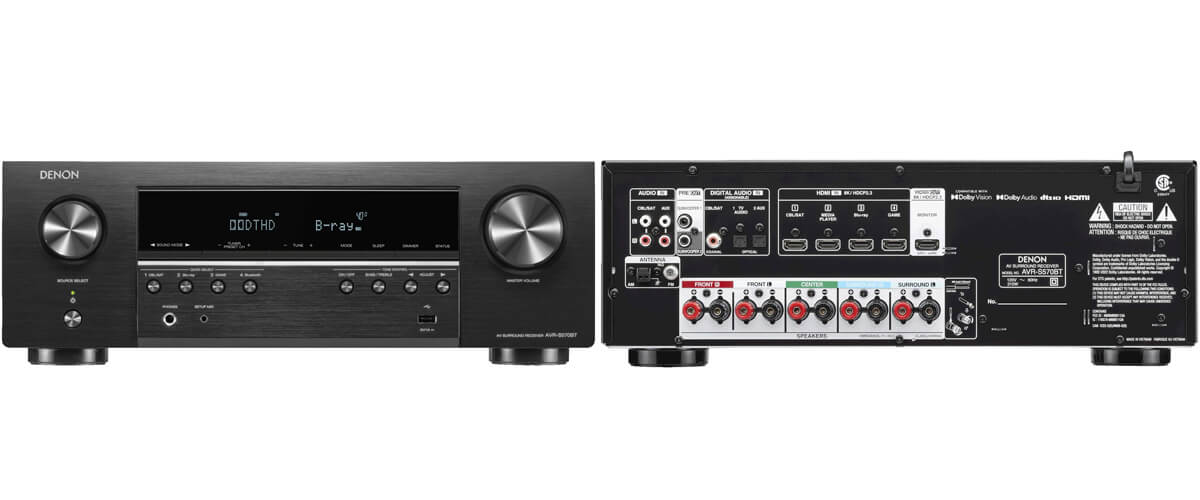
As always, having done a huge amount of work searching for receivers for this review, I came across a few interesting copies that were not included in the list. One of them is the S570BT from Denon.
For its price, it is a very high-quality receiver. It works well with various acoustics and is also quite suitable for movies and music. I set it up quickly and without problems. This model is also a good choice for modern game consoles, even with budget speakers. S570BT automatically detects the format of the audio stream at the input and reads almost everything. You can manually set the sound modes; the receiver will remember the choice, which is very convenient.
The sound is good, even very good. Still, it is a budget model, but Denon. It is not the limit of an audiophile’s dreams, but it surpassed all my expectations for entry-level equipment. My impressions from listening to music are also very positive.
Bluetooth is very necessary here (you’ll understand why a little later), and it plays major formats, including FLAC from USB media. However, this model has some significant disadvantages compared to other participants in my review.
First of all, the S570BT does not support Dolby Atmos. And secondly, it lacks Wi-Fi and Airplay. Nowadays, the lack of these features is a significant disadvantage for any device, even if we consider that in all other aspects, it’s a fine specimen. But that’s why I didn’t include this surround receiver under 500 in my main list.

